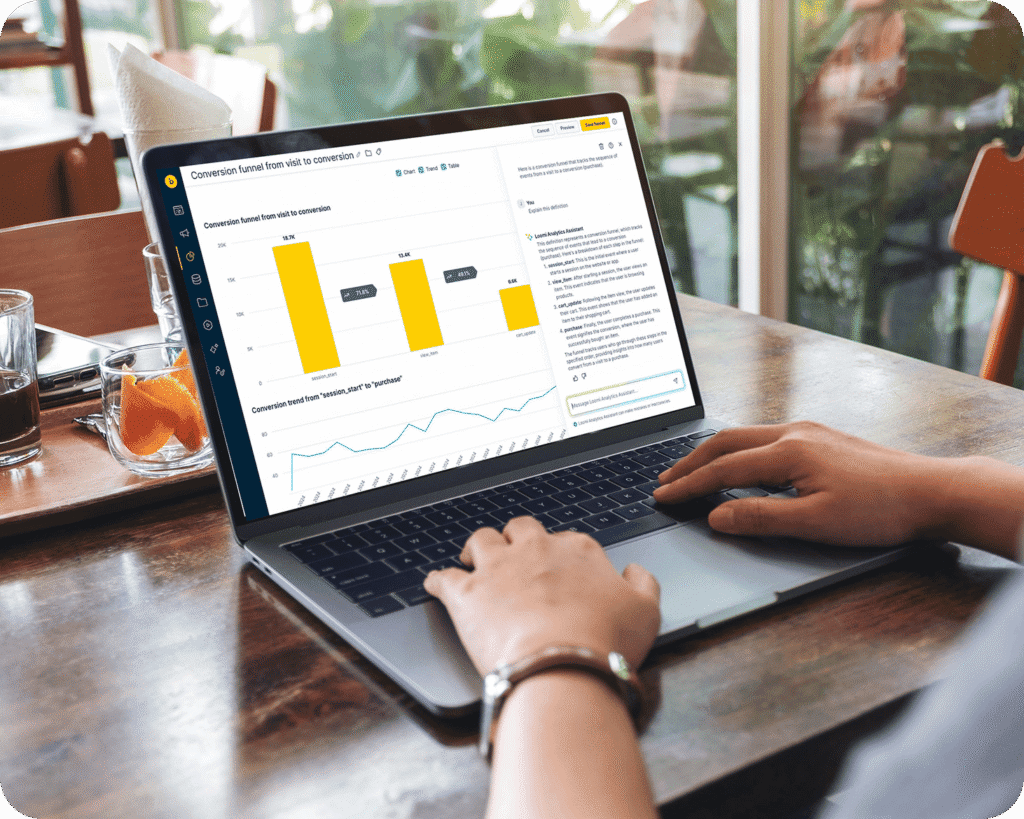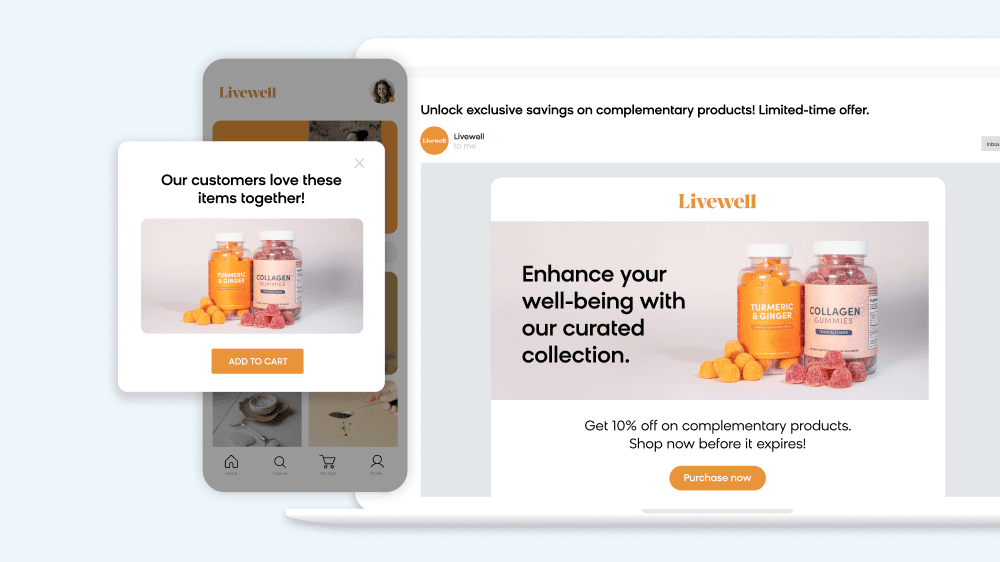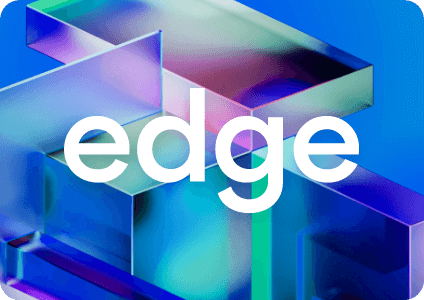From personalized recommendations to predictive analytics, machine learning is reshaping ecommerce and making it possible to engage customers in ways that weren’t possible before.
But AI is only as effective as the insights guiding it. Without tracking the right metrics, it’s impossible to know whether your machine learning efforts are boosting revenue, improving customer experiences, or missing the mark.
Measuring key data points like cart abandonment, customer lifetime value, and conversion rates can help you refine your AI strategy, ensure every algorithm works toward your goals, and maximize return on investment.
Let’s explore eight essential machine learning metrics that will help you track performance, optimize results, and turn AI into a true growth engine for your business.
Why Tracking Machine Learning Metrics Matters in Modern Ecommerce
In ecommerce, machine learning algorithms influence nearly every stage of the customer journey, from personalized recommendations to automated customer support and fraud detection. But online retailers can’t afford to assume AI is always working as intended. Without tracking key metrics, brands can risk investing in AI strategies that don’t actually move the needle on customer loyalty, revenue, or engagement.
Tracking the right metrics can help you identify what’s working, optimize marketing campaigns, and fine-tune AI models for better accuracy. By monitoring AI’s impact on key metrics like retention rate, return rate, and conversion rates, businesses can ensure their AI strategies aren’t just keeping up with industry trends but also actively boosting profitability.
Here’s why tracking these metrics is essential:
Measuring Success for Personalized Experiences
Today’s shoppers expect more than just convenience. They want an experience that feels personal. Machine learning enables this by analyzing customer behavior, predicting preferences, and delivering tailored recommendations in real time. However, personalization only works if it delivers measurable results.
Tracking metrics like conversion rates, click-through rates (CTR), and customer lifetime value (CLV) gives you insight into how well your AI is engaging customers. If these numbers are improving, your personalization efforts are working. A home decor brand, for example, might tailor recommendations based on the season and a shopper’s browsing history.
Optimizing Machine Learning Models
No machine learning model is perfect on the first try. AI learns over time, but it also needs fine-tuning to stay accurate and relevant. That’s where tracking performance metrics comes in.
Metrics like accuracy, precision, and recall help identify where your model is excelling and where it’s falling short. If product recommendations aren’t converting or search results aren’t relevant, these numbers can pinpoint the problem, whether it’s biased training data, outdated algorithms, or an overcomplicated model that’s slowing down predictions.
For example, an AI-powered search function that suggests irrelevant products might have a low precision score, meaning it frequently returns results that don’t match what the customer is looking for. By monitoring precision alongside user engagement metrics, you can refine the model to improve accuracy and relevance.

Proving ROI to Stakeholders
Investing in machine learning requires time and resources, so proving its value is essential. The right metrics help improve performance and demonstrate precise, data-backed results to decision-makers.
Metrics like customer acquisition cost (CAC), CLV, and revenue per visitor (RPV) show how AI-driven strategies impact business growth. If your AI improves ad targeting, CAC should decrease as campaigns become more efficient. If personalization is working, CLV should increase as customers engage more and spend more over time. These numbers make it easier to justify further investment in AI.
8 Key Machine Learning Metrics for Ecommerce Marketers
Without the right metrics, it’s impossible to know if your algorithms are improving customer engagement, increasing conversions, or simply running without real impact.
Not all metrics provide meaningful insights. Some may show surface-level trends, while others help fine-tune models and drive long-term growth. By tracking key metrics like cart abandonment, accuracy in recommendations, and customer acquisition cost (CAC), you gain the clarity needed to optimize AI strategies.
With the right data in hand, you can refine machine learning models, improve customer satisfaction, and ensure every AI-driven decision contributes to business success. Let’s break down the eight essential machine learning metrics every ecommerce store should track.
1. Cart Abandonment Rate
The cart abandonment rate measures the percentage of shoppers who add items to their cart but leave before completing the purchase. A high abandonment rate suggests potential roadblocks in the buying process, such as unexpected costs, a complicated checkout process, or concerns about security.
How to calculate it:

Once you identify abandonment patterns, machine learning helps address them in real time. AI detects why customers drop off and offers solutions tailored to each scenario. If high shipping costs lead to abandonment, AI can trigger free shipping pop-ups for high-value customers. If the checkout process is too long, AI suggests faster payment options. Machine learning also powers personalized retargeting campaigns, reminding shoppers about the items they left behind at the right moment.
2. Average Order Value (AOV)
AOV measures the average amount spent per order, making it a key indicator of revenue growth. Instead of relying solely on new customer acquisitions, increasing AOV allows you to maximize the value of each purchase.
How to calculate it:

Machine learning enhances AOV by optimizing upselling and cross-selling strategies.
- For upselling, AI analyzes a customer’s cart, browsing history, and past purchases to suggest higher-value alternatives. If someone is buying a smartphone, AI might recommend a premium model with enhanced features.
- For cross-selling, machine learning identifies complementary products based on purchases made by similar customers. If a shopper adds running shoes to their cart, AI may suggest performance socks or a hydration belt at just the right moment, often leading to a larger purchase.
3. Customer Acquisition Cost (CAC)
CAC tracks how much it costs to acquire a new customer. If this number is too high, your marketing efforts may not be efficient.
How to calculate it:

To lower CAC, focus on smarter ad targeting. AI analyzes customer behavior, past interactions, and predicted lifetime value to identify the best prospects. Instead of wasting budget on broad audiences, you can use AI to identify lookalike audience segments based on LTV or purchase intent.
From there, AI fine-tunes ad placements, adjusts bids in real time, and personalizes the creative to attract customers who are more likely to convert, helping you get the most out of your marketing budget.
4. Accuracy and Precision
AI aids in personalized recommendations, search results, and automated decision-making. But if these predictions aren’t accurate, they can frustrate customers and lead to lost sales. Accuracy and precision measure how well an AI model predicts outcomes — accuracy shows how often the model is right overall, while precision indicates how often its positive predictions are correct.
A search engine that returns irrelevant products may have high accuracy but low precision, meaning customers still struggle to find what they need. Machine learning continuously improves accuracy and precision by learning from real-time feedback loops. If users consistently click on one type of recommendation but ignore another, AI adjusts the weighting of certain product attributes. Similarly, AI-powered search engines refine their results by understanding context, synonyms, and purchase intent, making search results smarter and more relevant over time.
How to calculate them:

5. Customer Lifetime Value (CLV)
Customer lifetime value (CLV) measures how much revenue a business can expect from a single customer over their entire relationship. Instead of focusing only on short-term sales, CLV helps you understand how much you can invest in keeping customers coming back, making it essential for long-term profitability.
How to calculate it:

To increase CLV, focus on customer retention and repeat purchases. AI can identify shoppers who are at risk of leaving based on inactivity or shifts in behavior and trigger personalized incentives to bring them back. If a customer hasn’t purchased in months, sending a well-timed discount or product reminder based on their past orders can encourage them to return.
Loyalty programs are also more effective when they align with customer preferences. AI helps tailor rewards based on shopping habits, increasing engagement and long-term value. Post-purchase interactions also matter. AI determines the best time and channel to follow up, whether through email, SMS, in-app notifications, or more, to strengthen customer relationships and encourage future purchases.
6. Conversion Rates
Conversion rate measures how many visitors take a desired action (e.g., making a purchase). Even a small increase in conversions can have a big impact on revenue, making this one of the most important metrics for ecommerce success.
How to calculate it:

Machine learning helps optimize every step of the shopping journey to remove friction and encourage more purchases:
- Personalized recommendations: AI ensures customers see the most relevant products based on browsing history, past purchases, and real-time behavior
- Smarter A/B testing: Instead of manually testing one variation at a time, AI can run multiple versions of checkout designs, CTA buttons, and messaging to instantly identify what works best
- Timely nudges: AI predicts when a shopper might need an extra push, whether it’s a discount, a one-click checkout option, or a well-timed reminder about an abandoned cart
7. Click-Through Rate (CTR)
The click-through rate (CTR) measures how often users engage with a link in an ad, email, or search result. A low CTR often means your message isn’t resonating, making it harder to drive traffic and conversions.
How to calculate it:

By optimizing content, timing, and targeting in real time, machine learning takes the guesswork out of improving CTR. Here’s how it works:
- Smarter messaging: AI analyzes engagement patterns to refine subject lines, ad creatives, and on-site banners, ensuring they capture attention and encourage clicks.
- Personalized timing: Instead of sending emails or showing ads at a fixed time, AI determines when each user is most likely to engage and delivers messages accordingly.
- Optimized targeting: Machine learning continuously learns which audience segments respond best to different messaging styles, adjusting campaigns dynamically to maximize results.
8. Revenue per Visitor (RPV)
Revenue per visitor (RPV) shows how much revenue you earn from each site visitor. Unlike focusing on conversion rate alone, RPV provides a more holistic view by combining traffic quality, average order value (AOV), and how well your site converts visitors into customers.
How to calculate it:

Improving RPV often involves optimizing every step of the user journey. Intelligent product discovery ensures shoppers find what they need faster, resulting in smoother checkouts and higher purchase values. Artificial intelligence also predicts which visitors might need extra engagement, such as an AI-driven conversation, a time-sensitive discount, or personalized product recommendations, increasing the chances of a more valuable purchase.
How To Implement and Measure These Metrics Effectively
Tracking machine learning metrics is only the first step. The real value comes from using them to refine strategies, improve decision-making, and optimize AI-driven initiatives. To make these metrics actionable, businesses need a structured approach that ensures they align with ecommerce goals, leverage the right tools, and continuously improve based on real-time feedback. Here’s how to implement and measure machine learning metrics effectively.
Define Clear Business Goals
Before diving into tracking metrics, it’s essential to define what success looks like for your ecommerce business. Machine learning can optimize a wide range of areas, but without clear objectives, the data can become overwhelming or misinterpreted.
Are you looking to reduce cart abandonment, increase AOV, lower CAC, or improve CLV? Each goal requires a different set of optimizations and tracking methods.
For example, if your focus is on reducing customer churn, tracking CLV and retention patterns is key. If maximizing revenue is the priority, then conversion rate and revenue per visitor should be central to your strategy. Beyond financial goals, businesses also need to consider scalability and security, ensuring that AI-driven insights integrate seamlessly into existing operations without creating compliance risks or bottlenecks.
Use the Right Analytics Tools
The effectiveness of machine learning in ecommerce depends on the ability to track, process, and analyze large amounts of data in real time. Using advanced analytics tools ensures that machine learning models receive accurate and relevant data to improve their predictions and performance.
Some of the most effective tools for tracking machine learning metrics include:
- Customer data platforms (CDPs): Aggregate and unify customer interactions across multiple channels to improve personalization and segmentation (tip: you can also use a platform with a customer data engine to ingest this data more effectively)
- AI-driven ecommerce analytics tools: Platforms like Google Analytics 4 and Bloomreach Engagement track user behavior, conversion trends, and engagement metrics in real time
- Predictive analytics software: Tools like Loomi Analytics help businesses analyze historical trends to forecast future behavior and optimize decision-making
- A/B testing platforms: They enable ecommerce brands to test machine learning-driven personalization strategies and measure their direct impact
Collecting the right data is just as important as the tools used to analyze it. Transaction history, user interactions, demographics, purchase frequency, and product attributes all play a role in refining machine learning models. Businesses should ensure their data pipelines are well-structured and feed into AI systems without silos, enabling a holistic view of customer behavior.
Establish Feedback Loops
Machine learning models are only as good as the data they learn from. Without a continuous feedback loop, even the best AI models can become outdated, leading to poor recommendations, irrelevant marketing efforts, or missed revenue opportunities.
Implementing real-time monitoring and adaptive learning ensures that ML-driven systems evolve with customer behavior and market trends. Some ways to establish feedback loops include:
- Automated performance tracking: Set up automated dashboards to monitor key ecommerce metrics daily. If a metric like AOV or conversion rate suddenly drops, the system should trigger alerts.
- Customer behavior analysis: AI should analyze not just purchases but also abandoned carts, product views, and search behaviors to refine recommendation engines.
- Dynamic model adjustments: ML algorithms should retrain regularly, incorporating new data points such as seasonal trends, inventory fluctuations, and emerging purchase patterns.
- Human-in-the-loop interventions: While AI can optimize most processes, having human oversight ensures that errors or biases are identified and corrected before they affect revenue.
Prioritize Actionable Insights
Not all data points are equally useful. Businesses often fall into the trap of tracking too many metrics without clear action plans. The key is to focus on metrics that directly impact decision-making and drive measurable improvements.
For example, instead of just looking at the cart abandonment rate, businesses should analyze:
- What’s causing drop-offs (e.g., unexpected fees, slow checkout, or lack of payment options)
- Which recovery strategies work best (personalized emails vs. discounts)
- How different customer segments respond (first-time visitors vs. returning customers)
Similarly, when tracking customer acquisition costs, businesses shouldn’t just measure the cost per customer but also look at:
- Which acquisition channels lead to higher CLV?
- What’s the break-even point for CAC vs. revenue per visitor?
- How does ad spend optimization affect conversion rates?
How Bloomreach Simplifies Tracking and Optimizing Machine Learning Metrics
Tracking machine learning metrics only matters if it delivers real, measurable results for your business. That’s why Bloomreach Engagement is built for ecommerce marketers who want to simplify metric tracking and turn insights into growth. You get real-time analytics that reveal how cart abandonment, conversion rates, and customer lifetime value are changing, so you can adjust strategies before issues arise.
At the heart of Bloomreach Engagement is Loomi AI, an AI that predicts the best products, content, and messages for each shopper. This level of personalization can lead to higher RPV and stronger conversion rates because shoppers see exactly what they need, right when they need it. You also benefit from seamless autonomous marketing, which unifies email, SMS, web personalization, and ads in one intuitive platform.

Our customer data engine centralizes your online and offline data, giving you a complete view of each shopper’s interactions and preferences. This unified approach works with every major ecommerce platform and empowers you to make data-driven decisions that boost marketing performance.
Track Key Metrics To Drive Machine Learning Success
The right machine learning metrics — including cart abandonment rate, AOV, CAC, CLV, conversion rates, CTR, and RPV — give you a clear picture of what’s working and where to optimize. By tracking these key indicators, you can improve personalization, reduce acquisition costs, and increase revenue with data-backed decisions.
Bloomreach simplifies the process by providing real-time tracking, AI-powered insights, and seamless automation so you can focus on growing your ecommerce business instead of managing data. Whether it’s boosting conversion rates, refining customer segmentation, or optimizing ad spend, our platform helps you turn metrics into meaningful action.
Ready to see how AI-driven analytics can transform your marketing? Learn more about our autonomous marketing solution and start making smarter data-driven decisions.
















